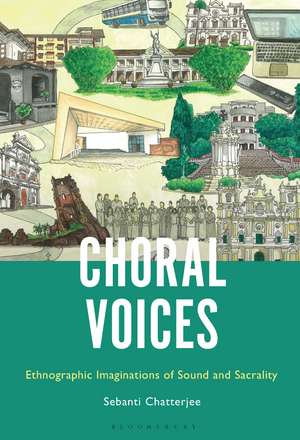Choral Voices: Ethnographic Imaginations of Sound and Sacrality
Autor Sebanti Chatterjeeen Limba Engleză Paperback – 21 aug 2024
| Toate formatele și edițiile | Preț | Express |
|---|---|---|
| Paperback (1) | 190.33 lei 3-5 săpt. | |
| Bloomsbury Publishing – 21 aug 2024 | 190.33 lei 3-5 săpt. | |
| Hardback (1) | 538.67 lei 6-8 săpt. | +113.67 lei 6-10 zile |
| Bloomsbury Publishing – 8 feb 2023 | 538.67 lei 6-8 săpt. | +113.67 lei 6-10 zile |
Preț: 190.33 lei
Preț vechi: 248.82 lei
-24% Nou
Puncte Express: 285
Preț estimativ în valută:
36.42€ • 39.68$ • 30.69£
36.42€ • 39.68$ • 30.69£
Carte disponibilă
Livrare economică 02-16 aprilie
Preluare comenzi: 021 569.72.76
Specificații
ISBN-13: 9781501379871
ISBN-10: 1501379879
Pagini: 208
Dimensiuni: 152 x 229 x 25 mm
Greutate: 0.29 kg
Editura: Bloomsbury Publishing
Colecția Bloomsbury Academic
Locul publicării:New York, United States
ISBN-10: 1501379879
Pagini: 208
Dimensiuni: 152 x 229 x 25 mm
Greutate: 0.29 kg
Editura: Bloomsbury Publishing
Colecția Bloomsbury Academic
Locul publicării:New York, United States
Caracteristici
Discusses the choral voice in various contexts including churches, seminaries, schools, university auditoriums, state auditoriums, privately managed auditoriums, classrooms, reality TV shows, festivals, and recording studios
Notă biografică
Sebanti Chaterjee is a sound anthropologist and a senior academic fellow at National Law School India University, Bengaluru. She is a recipient of India Foundation of Arts Research Grant, the Ryoichi Sasakawa Young Leaders Fellowship Fund (SRA FY 2016), the Indian Council of Social Science Research fellowship, and former editorial member of Serenade Magazine.
Cuprins
ListofIllustrationsPrologue: Warming Up1 Introduction: Choral beginnings: Inside the chapel and a home studio1.1 A biography of community- delineating the Sacred and the Heritage1.2 Establishing a musical cadence1.3 Framing choral music within Christian landscapes1.4 Aural Intentions: Summary of chapters2 Making of the Indigenous2.1 Interrogating the Indigenous2.2 Emplacing the Indigenous2.3 Understanding Indigeneity, Inculturality and Decoloniality2.4 Music and Decoloniality2.5 Exploring the relationship between Indigeneity and Sacrality2.6 Indigenous Possibilities in curricula and performance: Field narratives2.7 Towards Sonic Interculturality 3 From Loft to the Recording Studio: Shillong Diaries 3.1 What brings you to Shillong? Introduction3.2 Cusp of Sacrality, new Technologies and Creative Processes3.3 Choral Voices as ethnographic objects3.4 Short Historical Snippets about Christianity and Musicality in Khasi and Lushai Hills3.5 Discussing Genre, Intertextuality and Territorialisation3.6 Shillong Chamber Choir3.7 Repertoire- Medleys/Crossovers3.8 Beyond performance3.9 Aroha Choir3.10 Conclusion4 The Language of Music: Notes from a Goan Seminary4.1 Inhabiting the Seminary4.2 Outlining Goan Sacred Music4.3 A brief history of music and language in Goa 4.4 Entering the field site4.5 Rachol Seminary 4.6 Introducing the seminarians 4.7 Syncretic musical experimentations in Goan Sacred music 4.8 Goan Sacred music- Motets4.9 Conclusion5 Mapping Choral Voices: Role of People and Places5.1 Introduction5.2 Hierarchization of voices5.3 Indigeneity and Christian Music Tradition5.4 Music Performance5.5 Conclusion6 Tutti: Concluding Section6.1 The Musical Clef Notating Certainty- Uncertainty6.2 Positing the Vocal PhrasingAcknowledgmentsBibliographyGlossaryAppendixDocumentary - Da CapoIndex
Recenzii
Choral Voices is fantastic! In destabilizing notions of culture, colonization, and sound, Sebanti Chatterjee weaves a compelling story of belonging and faith. Through aural participation and multi-sited ethnography readers are transported to the overlooked arenas of identity and indigeneity in contemporary India, with crucial insights for worlds beyond.
Choral Voices is an important addition to the growing body of work that challenges fondly held notions of 'East' and 'West.'
This excellent study brings together an understanding of music, sound, voice, indigeneity, sacrality, and the ways in which these are knitted together in the choral music of Shillong and Goa. The book is also a moving personal account of crossing given religious, linguistic, regional, and cultural identities through the practice of music.
Sebanti Chatterjee constructs a beautifully detailed and captivating ethnographic account of Christian choral singing within contrasting locales in India. Highlighting colonial influence as well as indigenous agency, Chatterjee's account demonstrates the intertwining roles of faith and musical genre in creating a people's sacred imagination. Her book is an important addition to anthropological and ethnomusicological studies of Christian communities.
Sebanti Chatterjee's work is a significant contribution to the emerging field of voice studies in South Asia. Backed by a rich ethnography, it parses choral voices in multiple sites to revisit questions of repertoire, indigeneity and faith practice and in the process indexes a complex set of social relations and meaning making.
Choral Voices is an important addition to the growing body of work that challenges fondly held notions of 'East' and 'West.'
This excellent study brings together an understanding of music, sound, voice, indigeneity, sacrality, and the ways in which these are knitted together in the choral music of Shillong and Goa. The book is also a moving personal account of crossing given religious, linguistic, regional, and cultural identities through the practice of music.
Sebanti Chatterjee constructs a beautifully detailed and captivating ethnographic account of Christian choral singing within contrasting locales in India. Highlighting colonial influence as well as indigenous agency, Chatterjee's account demonstrates the intertwining roles of faith and musical genre in creating a people's sacred imagination. Her book is an important addition to anthropological and ethnomusicological studies of Christian communities.
Sebanti Chatterjee's work is a significant contribution to the emerging field of voice studies in South Asia. Backed by a rich ethnography, it parses choral voices in multiple sites to revisit questions of repertoire, indigeneity and faith practice and in the process indexes a complex set of social relations and meaning making.
